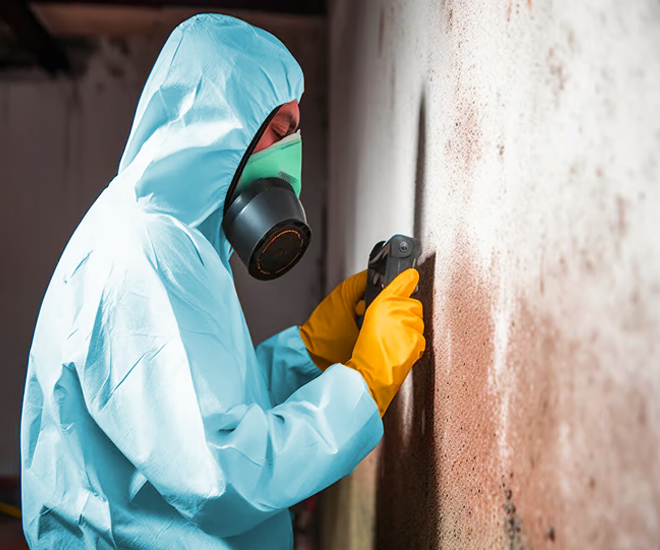Important Actions After Mold Remediation
Wiki Article
Specialist Tips for Message Mold And Mildew Remediation Success
In the realm of mold and mildew remediation, effectively eradicating mold and mildew is only half the battle; the real difficulty hinges on stopping its reappearance. Post-remediation efforts play an essential role in ensuring a mold-free atmosphere in the long-term. By sticking to expert ideas and ideal practices, people can guard their areas versus mold and mildew revival and preserve a healthy and balanced indoor setting. It is in this phase of the removal process that interest to information and proactive actions truly make a distinction.
Monitor Moisture Levels Frequently
After finishing mold and mildew removal procedures, maintaining optimal humidity degrees is vital to prevent mold re-growth and make sure a healthy indoor setting. High moisture degrees over 60% develop a conducive atmosphere for mold and mildew to thrive, making regular checking an aggressive action to prevent any future mold and mildew issues.Making use of hygrometers or dampness meters can help in accurately gauging moisture levels in various locations of the home. These tools provide real-time data that allows remediation experts to make enlightened choices concerning ventilation, dehumidification, and other required activities to keep perfect humidity levels post-remediation. Additionally, establishing a routine schedule for moisture checks, specifically in risky locations such as kitchens, basements, and shower rooms, is a proactive technique to mold avoidance. By continually monitoring moisture levels, home proprietors can effectively alleviate the risk of mold reoccurrence and preserve a healthy indoor setting post-remediation.
Conduct Thorough Inspections Post-Remediation
Adhering to the completion of mold remediation treatments, it is important to perform extensive inspections to validate the effectiveness of the removal process. These post-remediation examinations are important in making sure that the mold and mildew concern has actually been successfully attended to which there is no recurrence or staying mold and mildew growth. Evaluations ought to be accomplished by certified experts that have proficiency in determining mold and mildew and analyzing indoor air top quality.Throughout these examinations, numerous techniques such as aesthetic analyses, air tasting, and surface sampling may be used to thoroughly review the remediated areas. Aesthetic evaluations involve a comprehensive assessment of the premises to look for any kind of visible signs of mold growth or water damages. Air tasting helps in figuring out the airborne mold and mildew spore levels, while surface tasting can discover mold and mildew bits on surfaces.
Implement Correct Air Flow Approaches
After making sure the effectiveness of the mold removal process with extensive evaluations, the following essential action is to concentrate on implementing correct ventilation techniques. Appropriate ventilation is necessary in avoiding mold and mildew reoccurrence by regulating dampness degrees and promoting air blood circulation.
Correct air flow not just help in protecting against mold and mildew development but also adds to the overall health and comfort of passengers. By ensuring adequate ventilation throughout the property, you can lower the threat of mold regrowth and produce a much healthier living setting. Regular maintenance of ventilation systems, consisting of cleaning and filter replacements, is important to maintaining reliable air flow. Consulting with HVAC specialists can offer additional understandings into Post Mold Remediation optimizing air flow approaches for your specific building needs.

Usage Mold-Resistant Materials for Fixes
To improve the long-term performance of mold and mildew removal efforts, incorporating mold-resistant materials for fixings is important in mitigating the risk of future mold and mildew growth. Mold-resistant products are developed to withstand dampness and prevent mold and mildew growth, making them a vital selection for locations vulnerable to moisture and moisture. When fixing areas influenced by mold and mildew, using materials such as mold-resistant drywall, mold-resistant paints, and mold-resistant caulking can assist stop mold reappearance.Mold-resistant drywall is an exceptional option to typical drywall in locations like cellars and bathrooms where wetness degrees are greater. When subjected to damp conditions, this kind of drywall has a special coating that resists mold development also. In addition, using mold-resistant paints having antimicrobial agents can further inhibit mold development on ceilings and wall surfaces.
In locations where moisture is common, such as washrooms and kitchens, utilizing mold-resistant caulking around windows, sinks, and bathtubs can assist secure out water and stop mold from holding in fractures and gaps. By spending in these mold-resistant materials throughout repair services post-remediation, you can substantially reduce the chance of future mold and mildew issues and preserve a healthier indoor setting.
Maintain Tidiness and Address Water Issues
After mold and mildew removal, it is crucial to preserve a tidy setting to prevent the regrowth of mold. Leakages, water breach, or high moisture degrees can create the ideal breeding ground for mold and mildew, so it is essential to fix any kind of water-related issues quickly.To maintain tidiness, consider utilizing HEPA filters in vacuums and air purifiers to trap mold spores and prevent their blood circulation airborne. Furthermore, ensuring correct air flow in locations vulnerable to moisture build-up, such as kitchens and washrooms, can help keep humidity degrees in check. By staying attentive about sanitation and resolving water issues immediately, you can successfully avoid mold reinfestation and preserve a healthy indoor atmosphere.
Verdict

In the world of mold removal, efficiently eradicating mold is just half the fight; the real obstacle exists in stopping its reappearance. After completing mold remediation procedures, preserving optimal moisture levels is important to prevent mold and mildew re-growth and make certain a healthy and balanced indoor setting. High humidity levels above 60% develop a favorable setting for mold to thrive, making regular checking an aggressive procedure to stop any type of future mold issues.
To boost the long-lasting efficiency of mold removal efforts, integrating mold-resistant products for repair work is important in minimizing the danger of future mold and mildew development. After mold and mildew removal, it is vital to keep a tidy setting to prevent the regrowth of mold.
Report this wiki page